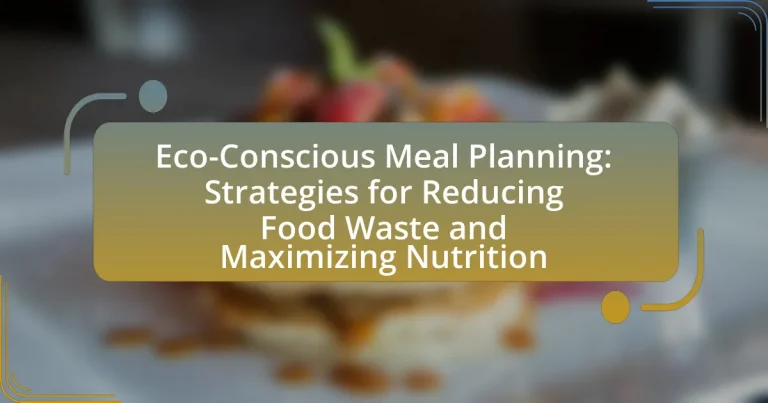Eco-Conscious Meal Planning is a sustainable approach to organizing meals that emphasizes minimizing food waste and maximizing nutritional value. This article explores the principles of eco-conscious meal planning, including the importance of selecting seasonal and local ingredients, reducing food waste, and focusing on plant-based meals. It highlights how effective meal planning can significantly decrease food waste, enhance nutritional intake, and promote healthier eating habits. Additionally, the article addresses common challenges faced in eco-conscious meal planning and offers practical strategies, including budgeting and utilizing technology, to overcome these barriers and support sustainable practices in daily meal preparation.

What is Eco-Conscious Meal Planning?
Eco-Conscious Meal Planning is the practice of organizing meals with a focus on sustainability, minimizing food waste, and maximizing nutritional value. This approach involves selecting seasonal and local ingredients, which reduces carbon footprints associated with transportation and supports local economies. Research indicates that food waste contributes significantly to greenhouse gas emissions, with approximately one-third of all food produced globally wasted, highlighting the importance of mindful meal planning in addressing environmental issues.
How does Eco-Conscious Meal Planning contribute to sustainability?
Eco-Conscious Meal Planning contributes to sustainability by minimizing food waste and optimizing resource use. By carefully selecting ingredients and planning meals, individuals can reduce the amount of food that goes uneaten, which is significant since approximately one-third of all food produced globally is wasted, contributing to greenhouse gas emissions. Additionally, eco-conscious meal planning often emphasizes seasonal and local produce, which reduces the carbon footprint associated with transportation and supports local economies. This approach not only fosters a more sustainable food system but also encourages healthier eating habits, as it typically involves whole, unprocessed foods.
What are the key principles of Eco-Conscious Meal Planning?
The key principles of Eco-Conscious Meal Planning include prioritizing seasonal and local ingredients, minimizing food waste, and focusing on plant-based meals. Seasonal and local ingredients reduce the carbon footprint associated with transportation and support local economies. Minimizing food waste involves planning meals carefully, using leftovers creatively, and composting when possible, which can significantly decrease the amount of food that ends up in landfills. Focusing on plant-based meals is essential as they generally require fewer resources and produce lower greenhouse gas emissions compared to animal-based foods. These principles collectively contribute to a more sustainable food system and promote environmental health.
How does meal planning impact food waste reduction?
Meal planning significantly reduces food waste by promoting efficient grocery shopping and meal preparation. When individuals plan their meals, they create specific shopping lists that align with their intended recipes, minimizing impulse purchases and excess food that may go unused. Research indicates that households that engage in meal planning can reduce food waste by up to 50%, as they are less likely to buy items they do not need or consume. This structured approach not only conserves resources but also encourages the use of perishable items before they spoil, further decreasing waste.
Why is nutrition important in meal planning?
Nutrition is important in meal planning because it ensures that individuals receive the essential nutrients required for optimal health and well-being. Proper meal planning incorporates a balance of macronutrients—carbohydrates, proteins, and fats—as well as micronutrients such as vitamins and minerals, which are crucial for bodily functions. Research indicates that a well-balanced diet can reduce the risk of chronic diseases, improve mental health, and enhance overall quality of life. For instance, the World Health Organization emphasizes that adequate nutrition is vital for maintaining health and preventing malnutrition in all its forms.
What nutrients should be prioritized in eco-conscious meals?
Eco-conscious meals should prioritize nutrients such as protein, fiber, vitamins, and minerals. Protein sources like legumes and nuts are sustainable and provide essential amino acids, while fiber from whole grains and vegetables aids digestion and reduces food waste by promoting satiety. Vitamins, particularly from fruits and vegetables, support overall health, and minerals like iron and calcium are crucial for bodily functions. Research indicates that plant-based diets, which emphasize these nutrients, can significantly lower carbon footprints while maintaining nutritional adequacy. For instance, a study published in the journal “Nature” found that shifting towards plant-based diets could reduce greenhouse gas emissions by up to 70%.
How can meal planning enhance nutritional intake?
Meal planning enhances nutritional intake by allowing individuals to strategically select and prepare balanced meals that meet dietary needs. This proactive approach ensures a variety of food groups are included, which can lead to improved nutrient density in daily consumption. Research indicates that individuals who engage in meal planning are more likely to consume fruits, vegetables, and whole grains, while reducing intake of processed foods high in sugars and unhealthy fats. A study published in the Journal of Nutrition Education and Behavior found that meal planners reported higher overall diet quality and better adherence to dietary guidelines compared to non-planners.
What are the common challenges in Eco-Conscious Meal Planning?
Common challenges in eco-conscious meal planning include sourcing sustainable ingredients, managing food waste, and balancing nutrition with environmental impact. Sourcing sustainable ingredients can be difficult due to limited availability and higher costs associated with organic and local produce. Managing food waste is another significant challenge, as it requires careful planning to ensure that purchased items are used before they spoil. Additionally, balancing nutritional needs while adhering to eco-conscious principles can complicate meal planning, as some environmentally friendly options may not provide adequate nutrients. These challenges highlight the complexities involved in creating meals that are both environmentally sustainable and nutritionally adequate.
How can individuals overcome barriers to effective meal planning?
Individuals can overcome barriers to effective meal planning by setting clear goals, utilizing meal prep techniques, and leveraging technology. Setting specific, achievable goals helps individuals focus on what they want to accomplish, such as reducing food waste or maximizing nutrition. Meal prep techniques, such as batch cooking and portioning meals in advance, streamline the cooking process and save time during busy weeks. Additionally, using apps and online resources for meal planning can provide inspiration and organization, making it easier to stick to a plan. Research indicates that structured meal planning can lead to healthier eating habits and reduced food waste, supporting the effectiveness of these strategies.
What role does budgeting play in meal planning?
Budgeting plays a crucial role in meal planning by ensuring that individuals allocate financial resources effectively to meet their nutritional needs while minimizing food waste. A well-structured budget allows for the selection of cost-effective ingredients, which can lead to healthier meal choices and reduced spending on unnecessary items. Research indicates that households that adhere to a budget are more likely to plan meals in advance, resulting in a 20% reduction in food waste, as they purchase only what is needed for their planned meals. This strategic approach not only supports financial stability but also promotes eco-conscious practices by reducing the environmental impact associated with food waste.

What strategies can be employed to reduce food waste?
To reduce food waste, strategies such as meal planning, proper food storage, and utilizing leftovers can be employed. Meal planning helps consumers buy only what they need, thereby minimizing excess purchases that may go to waste. Proper food storage techniques, including using airtight containers and understanding expiration dates, can extend the shelf life of perishable items. Additionally, creatively using leftovers in new recipes can ensure that food is consumed rather than discarded. According to the Food and Agriculture Organization, approximately one-third of all food produced globally is wasted, highlighting the importance of these strategies in addressing food waste effectively.
How can meal prep techniques minimize waste?
Meal prep techniques minimize waste by allowing individuals to plan and portion meals in advance, which reduces the likelihood of food spoilage and over-purchasing. By preparing meals in bulk and using ingredients efficiently, individuals can utilize perishable items before they expire, thereby decreasing the amount of food that is thrown away. Research indicates that meal prepping can lead to a 30% reduction in food waste, as it encourages the use of leftovers and promotes mindful consumption.
What are the best practices for storing food to extend shelf life?
The best practices for storing food to extend shelf life include keeping food in airtight containers, maintaining appropriate temperatures, and using proper labeling. Airtight containers prevent moisture and air exposure, which can lead to spoilage; for example, storing grains in sealed jars can extend their freshness significantly. Maintaining appropriate temperatures, such as refrigerating perishable items below 40°F (4°C), slows bacterial growth, thereby prolonging shelf life. Additionally, labeling food with dates helps track freshness and encourages the use of older items first, reducing waste. These practices are supported by food safety guidelines from organizations like the USDA, which emphasize the importance of proper storage techniques in preventing food spoilage and waste.
How can leftovers be creatively repurposed in meal planning?
Leftovers can be creatively repurposed in meal planning by transforming them into new dishes, thereby reducing food waste and maximizing nutrition. For instance, roasted vegetables can be blended into soups or used in frittatas, while cooked grains like rice or quinoa can serve as a base for salads or stir-fries. Additionally, leftover proteins such as chicken or beef can be incorporated into tacos, sandwiches, or casseroles. This approach not only enhances meal variety but also ensures that nutritious ingredients are utilized effectively, contributing to a more sustainable food system.
What role does seasonal eating play in reducing waste?
Seasonal eating significantly reduces waste by promoting the consumption of locally grown produce at its peak freshness, which minimizes spoilage and transportation waste. When consumers choose seasonal foods, they are more likely to purchase items that are abundant and thus less likely to be discarded due to overproduction or lack of demand. For example, a study by the Food and Agriculture Organization indicates that seasonal fruits and vegetables have a lower carbon footprint and are less likely to be wasted compared to out-of-season imports, which often require refrigeration and long-distance transport. This practice not only supports local economies but also encourages sustainable agricultural practices, further contributing to waste reduction.
How can consumers identify and choose seasonal produce?
Consumers can identify and choose seasonal produce by understanding the growing cycles of fruits and vegetables in their region. Seasonal produce is typically fresher, more flavorful, and often more affordable due to lower transportation costs. For example, in the United States, strawberries are in season from April to June, while pumpkins are harvested in the fall. Consumers can refer to local farmers’ markets, seasonal produce guides, or agricultural extension services to determine what is in season. Additionally, many grocery stores label produce with its growing season, helping consumers make informed choices.
What are the environmental benefits of eating locally sourced foods?
Eating locally sourced foods significantly reduces carbon emissions associated with transportation. When food is grown and consumed within the same region, it minimizes the distance traveled, which in turn lowers greenhouse gas emissions from vehicles. For instance, a study by the USDA found that food transported over long distances can generate up to 11 times more carbon emissions compared to locally sourced options. Additionally, local food systems often promote sustainable farming practices that enhance soil health and biodiversity, further contributing to environmental preservation. By supporting local agriculture, consumers also help reduce reliance on industrial farming methods that can lead to habitat destruction and pollution.

How can meal planning maximize nutrition?
Meal planning can maximize nutrition by ensuring a balanced intake of essential nutrients through careful selection and preparation of meals. By planning meals in advance, individuals can incorporate a variety of food groups, such as fruits, vegetables, whole grains, lean proteins, and healthy fats, which collectively provide vitamins, minerals, and other nutrients necessary for optimal health. Research indicates that meal planning is associated with improved dietary quality; for instance, a study published in the Journal of Nutrition Education and Behavior found that individuals who engage in meal planning consume more fruits and vegetables and have a higher overall diet quality compared to those who do not plan their meals. This structured approach not only enhances nutritional intake but also reduces the likelihood of impulsive, less nutritious food choices.
What are the benefits of incorporating diverse food groups?
Incorporating diverse food groups enhances nutritional intake and promotes overall health. A varied diet ensures that individuals receive a wide range of essential nutrients, including vitamins, minerals, and antioxidants, which are crucial for bodily functions. For instance, the Dietary Guidelines for Americans recommend consuming a variety of fruits, vegetables, whole grains, proteins, and dairy to meet nutritional needs effectively. Research indicates that diets rich in diverse food groups can reduce the risk of chronic diseases, such as heart disease and diabetes, by providing protective nutrients and improving gut health through a diverse microbiome.
How can variety in meals improve overall health?
Variety in meals can improve overall health by ensuring a diverse intake of essential nutrients. Consuming a wide range of foods helps to provide vitamins, minerals, and antioxidants that are crucial for bodily functions and disease prevention. For instance, a study published in the journal “Nutrients” found that individuals who eat a varied diet are more likely to meet their nutritional needs and maintain a healthy weight. This diversity can also enhance gut health by promoting a balanced microbiome, as different foods support different beneficial bacteria. Therefore, incorporating a variety of foods into meal planning not only maximizes nutrition but also contributes to better overall health outcomes.
What are some examples of balanced meal combinations?
Balanced meal combinations include grilled chicken with quinoa and steamed broccoli, a lentil salad with mixed greens and cherry tomatoes, and baked salmon with brown rice and asparagus. These combinations provide a source of lean protein, whole grains, and a variety of vegetables, ensuring a well-rounded intake of essential nutrients. For instance, grilled chicken offers protein and iron, quinoa provides fiber and complex carbohydrates, while broccoli adds vitamins C and K. Such meals align with nutritional guidelines that emphasize the importance of diverse food groups for optimal health.
How can technology assist in meal planning?
Technology assists in meal planning by providing tools that streamline recipe selection, grocery shopping, and nutritional tracking. Applications and websites can analyze dietary preferences and restrictions, suggest recipes based on available ingredients, and create shopping lists to minimize food waste. For instance, meal planning apps like Mealime and Yummly allow users to input their dietary needs and generate tailored meal plans, which can lead to more efficient grocery shopping and reduced food waste. Additionally, smart kitchen devices can help monitor food inventory and expiration dates, further supporting eco-conscious practices by encouraging the use of ingredients before they spoil.
What apps or tools are available for eco-conscious meal planning?
Several apps and tools are available for eco-conscious meal planning, including Mealime, Yummly, and Eat This Much. Mealime allows users to create personalized meal plans based on dietary preferences and generates shopping lists to minimize food waste. Yummly offers recipe suggestions that consider seasonal ingredients and dietary restrictions, promoting sustainable eating habits. Eat This Much automates meal planning by generating balanced meal options based on user-defined calorie goals and preferences, helping to reduce food waste by optimizing ingredient use. These tools collectively support eco-conscious meal planning by emphasizing sustainability and nutrition.
How can online resources enhance nutritional knowledge?
Online resources can enhance nutritional knowledge by providing accessible, evidence-based information on dietary guidelines, food composition, and meal planning strategies. Websites, online courses, and mobile applications offer interactive tools and resources that help individuals understand nutritional concepts, track their food intake, and make informed dietary choices. For instance, the USDA’s MyPlate initiative offers guidelines and resources that promote balanced eating, while platforms like NutritionData provide detailed nutritional information about various foods. Research indicates that individuals who utilize online nutrition resources demonstrate improved dietary habits and increased knowledge about healthy eating practices.
What practical tips can help individuals implement eco-conscious meal planning?
To implement eco-conscious meal planning, individuals should focus on creating a weekly meal plan that emphasizes seasonal and local ingredients. This approach reduces the carbon footprint associated with transportation and supports local farmers. Additionally, individuals can practice batch cooking and portion control to minimize food waste, as studies show that meal planning can reduce food waste by up to 50%. Incorporating plant-based meals into the diet also contributes to sustainability, as plant-based foods generally require fewer resources than animal products. Lastly, utilizing leftovers creatively can further decrease waste and enhance meal variety.


